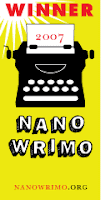
In April I spoke about the National Novel Writing Month and its manual, No Plot, No Problem. At that time I did not mention that I would be taking the Nanowrimo challenge and writing a novel in November 2007. The month is over and while my novel is not complete, I have passed the fifty thousand word minimum word limit. I am mostly through part 2 of a three part novel entitled Artemis Alexander.
The process has been liberating for me. I am a fan of Kenneth Atchity's approach to writing non-fiction as developed in A Writer's Time, in which the mantra is "Don't write the first word of the first draft until you know the last word of the last draft." This approach has saved me from many false starts and, despite all of the front loading in the writing process, has made my essay writing more efficient.
But I have wanted to try my hand at fiction, and when i have tried the same approach I haven't been able to get anything going.
So starting on November 1st I took the recommendation of Chris Baty in No Plot No Problem. I conjured up some characters, put them in some scenes, and watched them interact, writing as I watched. Things came together surprisingly smoothly.
I have no ambitions for my novel. But the experience was priceless, and I learned a lot about writing I never could have learned by writing philosophical essays -- or reading anything about writing.













